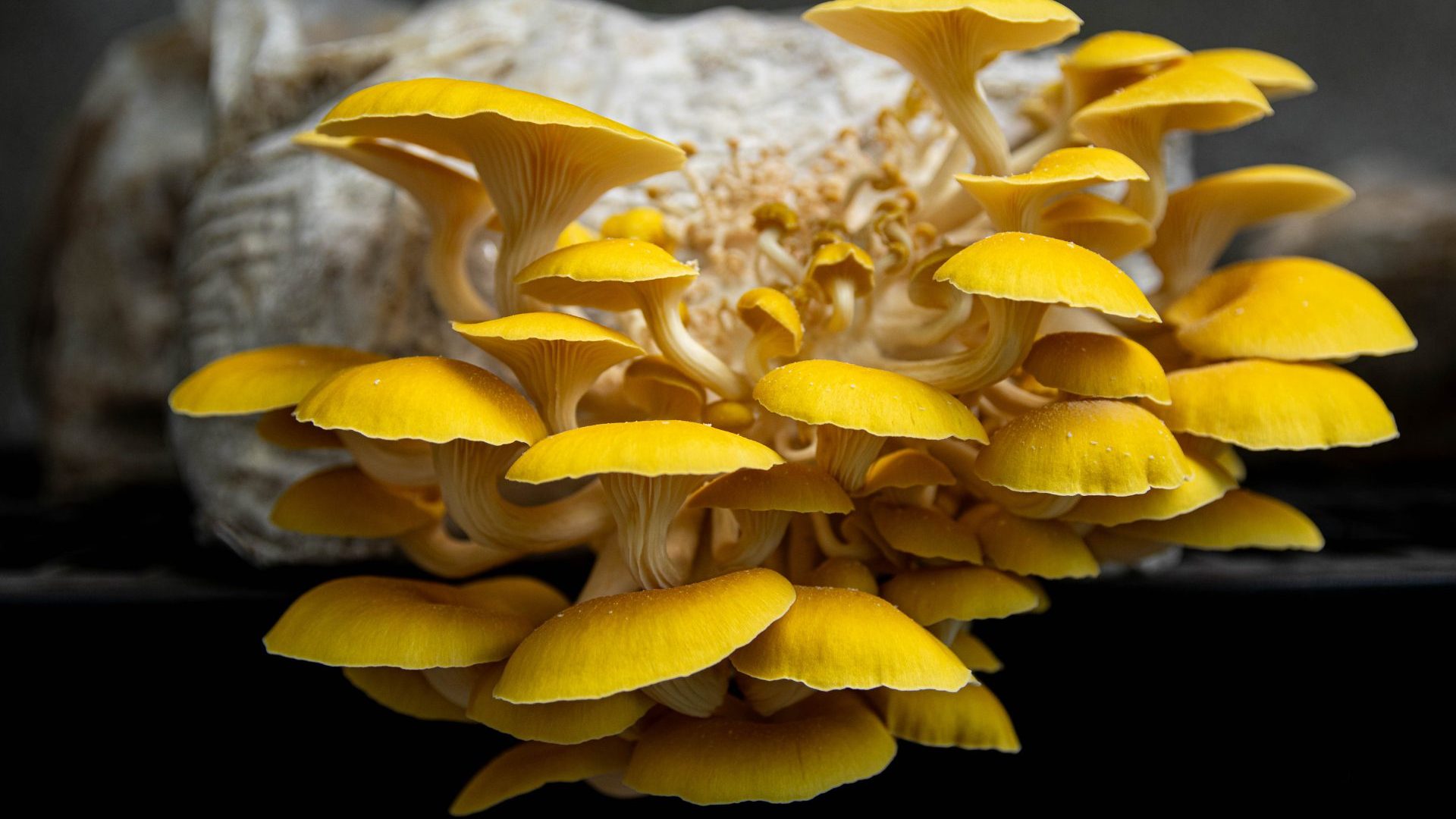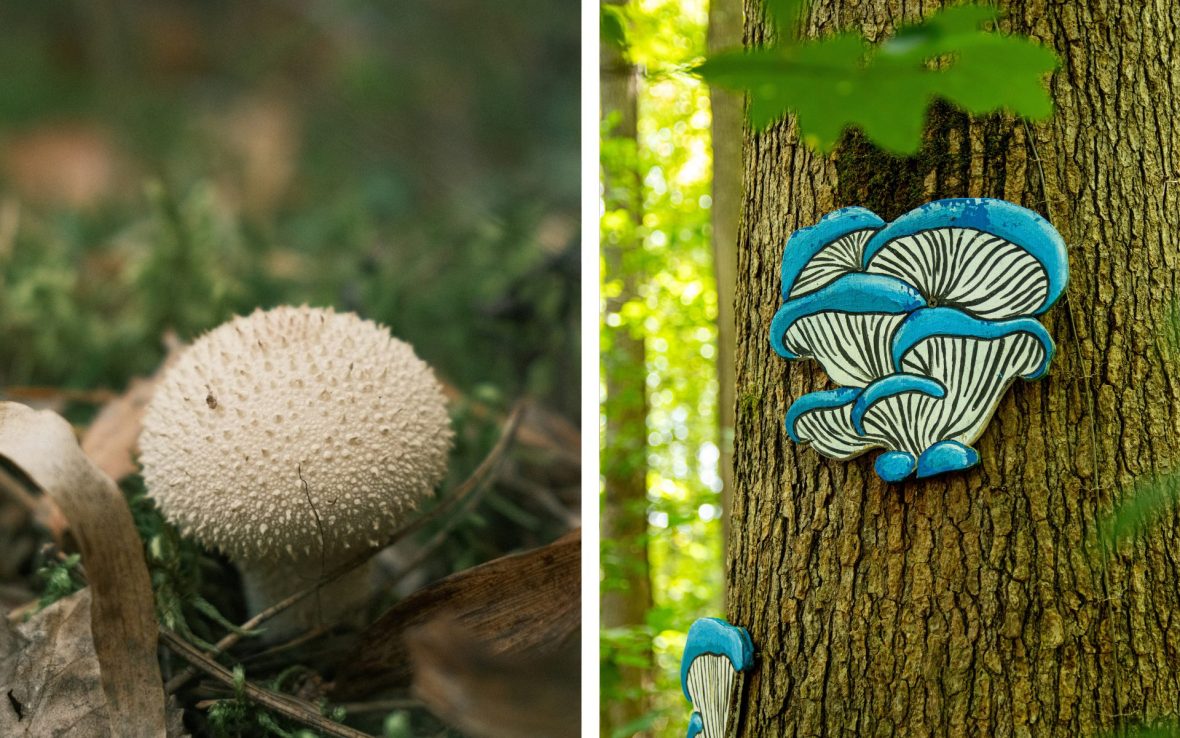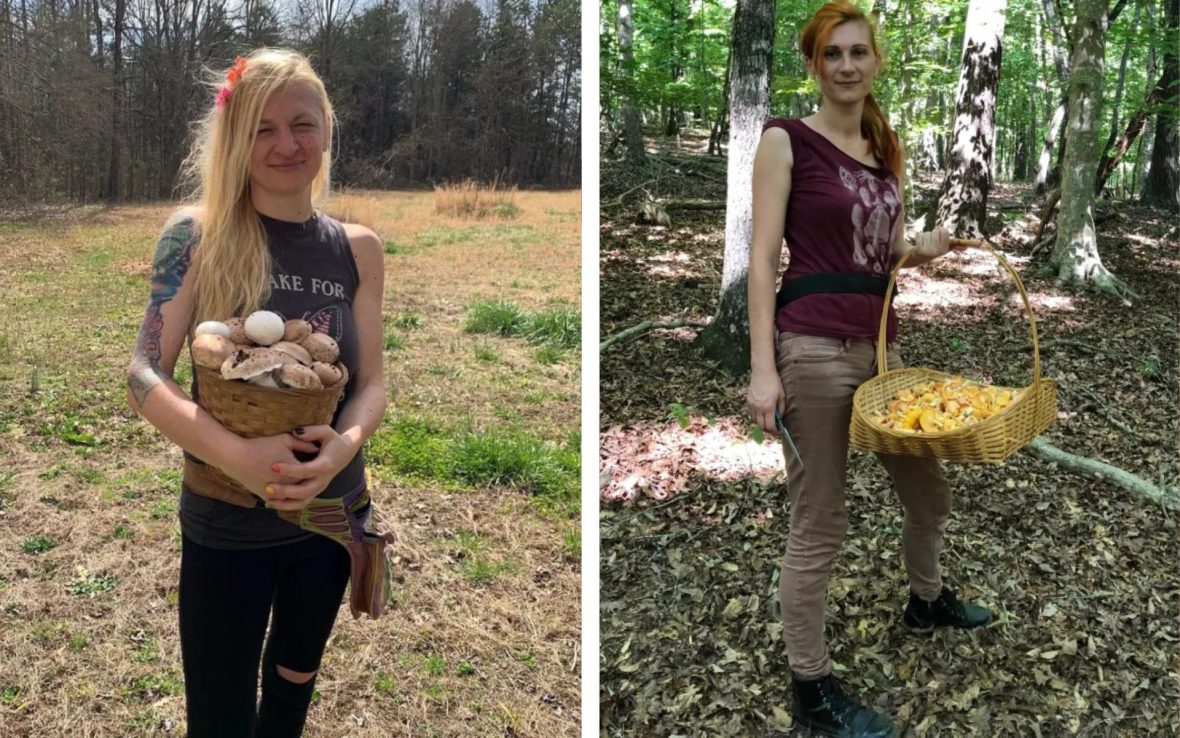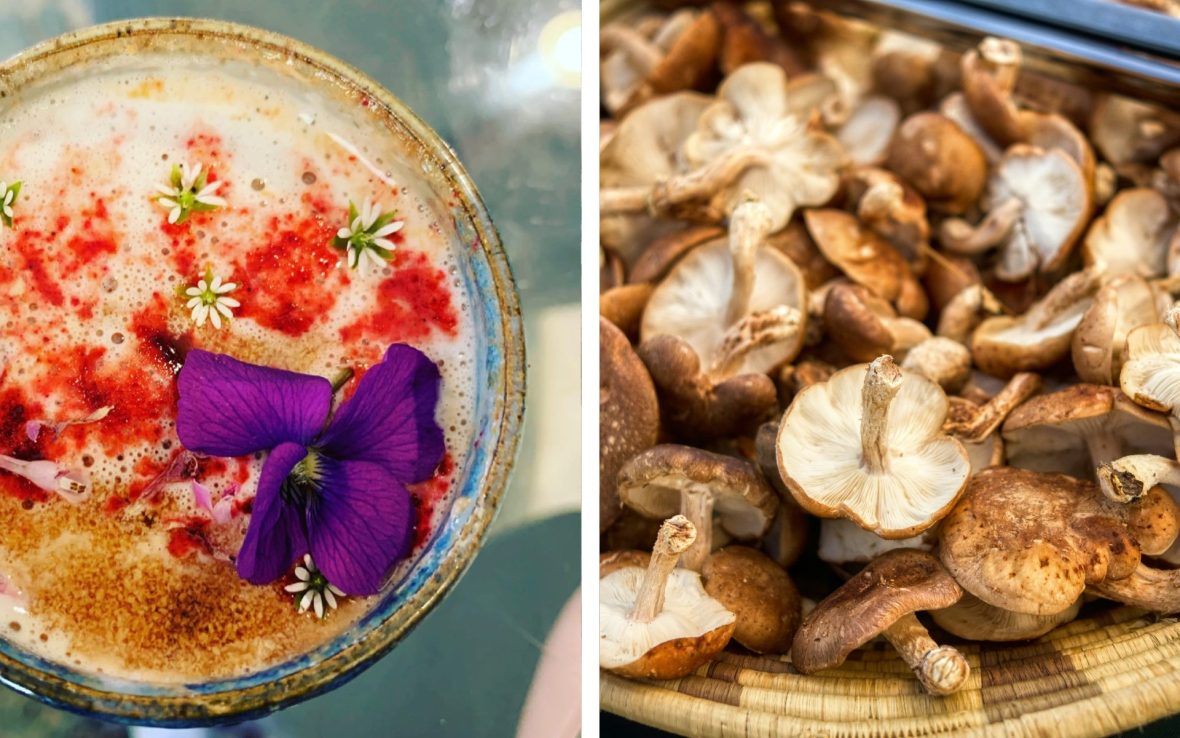
On a recent trip to South Carolina’s Mushroom Mountain, writer—and experienced forager—Nevin Martell steps into an otherworldly shroomiverse.


On a recent trip to South Carolina’s Mushroom Mountain, writer—and experienced forager—Nevin Martell steps into an otherworldly shroomiverse.
“Let’s go on the mushroom trail,” says Billie Katic, motioning for us to follow her down a dirt pathway leading into the forest. Dressed in bleached indigo jeans and a pale turquoise t-shirt that highlights her long, fiery orange hair, Billie is a 21st-century vision of a woodland’s nymph.
Moving under the cover of foliage on a muggy South Carolina afternoon in late September, Billie takes us by patches of cleared land, each a cultivation area for various mushroom varieties.
“Here are some puffballs,” she says, pointing at grapefruit-sized white orbs dotting the ground. “A lot of kids love them because you can push them, and smoke comes out. It’s actually spores coming out. They can get really big, but as long as they’re white on the inside, you can fry them up and eat them.”

Further on, she gestures to a scattering of mushrooms that look straight out of a fairytale. “This is a section of bioluminescent fungi,” she says. “It’s really cool to come out at night and see them glow in the dark. You have to sit there for a few minutes, and then slowly your eyes will get adjusted, and you’ll see their light.”
A longtime forager and mushroom buff, I feel giddy seeing all these shrooms in one place. Elvis enthusiasts journey to Graceland. Pagans make pilgrimages to Stonehenge. Fungi fans come here.
This living museum, which is just one element of the appropriately named Mushroom Mountain, an 18-acre all-things-shroom multiverse in Easley, South Carolina, just west of Greenville, helmed by a pair of Bosnian sisters, owner Olga and her sister, Billie, who serves as its creative director.
“Cordyceps are a really strong energizer. I don’t take them after five or six in the evening, because then I’ll stay up all night. Plus, they modulate your immune system, control sugar levels, and help with cholesterol regulation.”
- Billie Katic, co-founder Mushroom Mountain
The sisters left their homeland in 1991, as conflict brewed in the region, and Serbia was on the verge of invading. They fled with their parents to Croatia, then on to Austria, Germany, Canada, and, lastly, the States, where they ultimately ended up in South Carolina. “It’s tragic,” says Olga, “but if it didn’t happen, we wouldn’t be here.”
“Luckily, my sister and I had each other each step of the way,” adds Billie.
The pair started their mushroom business in 2007, from home initially. It was a natural line of work for them to pursue. “Mushrooms were always a hobby for us, because we come from that culture where we pick mushrooms in the woods with our grandparents and our parents,” says Olga. “It’s a Slavic thing.”
These days, they grow roughly 80 different species of mushrooms. Some are edible, such as oyster mushrooms and morels. Others have purported medicinal or wellness benefits, so they are transformed into extracts and infused with honey.
“Cordyceps mushrooms are a really strong energizer,” says Billie. “I don’t take them after five or six in the evening, because then I’ll stay up all night. Plus, they modulate your immune system, control sugar levels, and help with cholesterol regulation. Then there are lion’s mane, which are great for nerve restoration, brain health, and your gut.”
Other mushrooms grown on the property are used for mycoremidiation and bioremediation—the breaking down, transformation, or elimination of contaminants in the environment. Some are utilized to help speed up the decay of tree stumps and other landscape waste. Others still become decorative landscaping, like the glow-in-the-dark jack-o’-lantern mushrooms in front of us.
I have always approached mushrooms as a purely culinary proposition. My annual calendar is set by mushroom hunts and the ensuing feasts: Springtime morels, chanterelles in the summer, and maitakes when autumn’s blush sets in. It’s not that I don’t believe mushrooms could have myriad health benefits, I just haven’t felt the need to specifically seek any relief or remedy from them to see if they might work for me. Yet.

Our tour includes a stop at Mushroom Mountain’s lab, where a couple of technicians— affectionately referred to as ‘labbies’—are working. Around them, shelves are lined with bottles full of mushrooms stewing in alcohol to create extracts, and bags packed with substrate [the surface on which an organism, like a plant, fungus, or animal, lives] impregnated with mushroom spawn, so customers can grow their own mushrooms at home.
There are several larger bags that are experiments as the team works to figure out how to cultivate notoriously difficult-to-propagate mushrooms—such as morels, chicken of the woods, maitake, and cauliflower mushrooms—which all have vital, complex, still-not-fully-understood relationships with trees.
Take morels, which have a mycorrhizal partnership with certain trees, including tulip poplar, elm, apple, and sycamore. This symbiotic give and take involves the mushrooms receiving carbohydrates from the tree, while giving back water and nutrients. Fully understanding and replicating those systems is still a work in progress.
Umami-packed oyster mushroom pâte comes smeared on crackers with sprigs of fresh chickweed, which tastes surprisingly like corn silk. Then there’s pizza with a maitake infused crust dotted with lion’s mane and cauliflower mushrooms.
On top of all this work, Mushroom Mountain is a thriving education center. They offer professional courses certifying people who want to forage edible wild mushrooms to sell to restaurants and markets; they’re currently taught in more than half a dozen states, including North Carolina, Virginia, New York, and Rhode Island.
But plenty of visitors are simply mushroom-curious tourists and school groups. Billie even wrote a children’s book, Mushroom Safari, to help younger visitors get over any mushroom phobia. “They’re probably just taught by their parents to avoid mushrooms because they could be dangerous, but we want to give them the knowledge about their benefits and why they’re good,” she says. “We still tell them you never eat mushrooms raw. And you only eat them if you have a parent or somebody else who can tell you that they’re safe.”
This is vital advice. There’s an old joke amongst foragers: “All mushrooms are edible. At least once.” Eat the wrong one and you could end up in the E.R., burdened with a lifetime of painful health complications, or a coffin.

Thankfully, that’s not a worry at Mushroom Mountain. Our visit ends with a shroomy feast of delicious, safe-to-eat species. Umami-packed oyster mushroom pâte comes smeared on crackers with sprigs of fresh chickweed, which tastes surprisingly like corn silk. Then there’s pizza with a maitake-infused crust sprinkled with lion’s mane and cauliflower mushrooms.
The finisher is an espresso-amped brownie concealing cordyceps, chaga, and lion’s mane mushrooms. Luckily, it’s still early afternoon, so neither the energizing mushrooms nor the caffeine should keep me up tonight. With any luck, I’ll be able to sleep easy and dream deeply of my trip down this fantastical fungi rabbit hole, which broadened my views on the uses and benefits of mushrooms.
As I’m leaving, I vow to add lion’s mane mushrooms into my supplements lineup to see if they can sharpen my mind. More brain power is always a good thing, especially when you’ve treated your frontal cortex like an amusement park, as I sometimes have done. Or maybe I’ll plant some jack-o’-lantern mushrooms in my backyard to create a trippy light show to enjoy after a dinner of whatever delectable wild mushrooms are in season. That sounds like a perfect evening.
****
Adventure.com strives to be a low-emissions travel publication. We are powered by, but editorially independent of, Intrepid Travel, the world’s largest travel B Corp, who help ensure Adventure.com maintains high standards of sustainability in our work and activities. You can visit our sustainability page or read our Contributor Impact Guidelines for more information.








Can't find what you're looking for? Try using these tags: